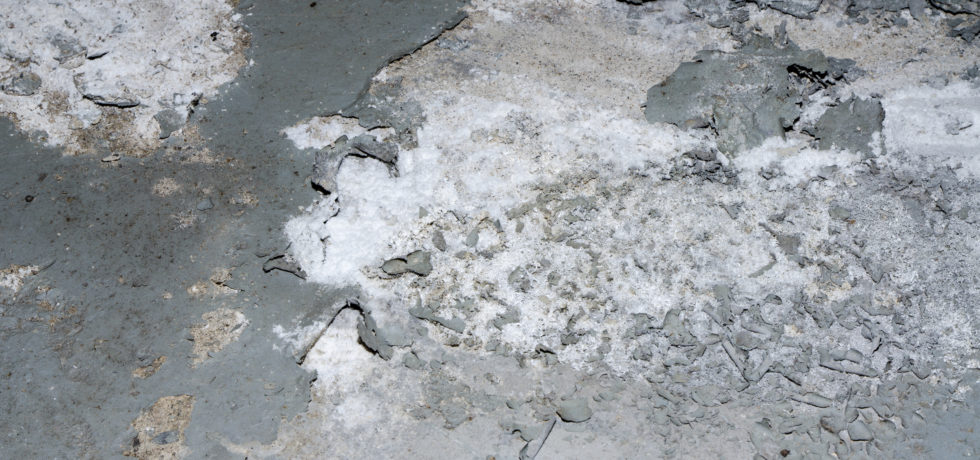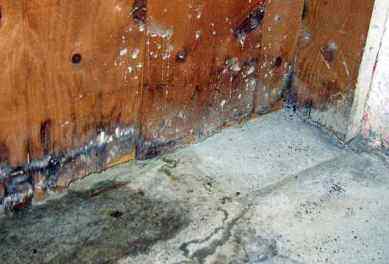Category
- Concrete Best Practices
- Most Popular
You’ve just moved into a suite in a brand-new condo. You’ve parked your car in the below grade garage you just paid extra for when you notice something on the nearby concrete wall. Upon closer inspection, you see fluffy white stuff on the concrete everywhere, seemingly coming out of hairline cracks.
What could this be?
You turn to Google for answers, and now, you find yourself facing this article right here! Well, you’re in luck. As a thought leader for concrete construction, we care deeply about the quality of concrete everywhere. So we’re here to guide you on what that white stuff is and what you should do about it.
Determine the Cause First
So, what is that white stuff? Depending on the cause, it could very likely be harmless. But you first need to identify that cause. There are three likely causes for such white stuff on your concrete walls, and we’ll go through each in detail.
Cause #1: Efflorescence
The first potential cause we’ll look into is efflorescence. It’s what happens when salt deposits have been left behind after water has seeped through a building material like concrete, brick, or stone and evaporated. And it’s more often seen in older buildings.
But more importantly, it is generally harmless. While you might think it’s a deadly fungus at first glance, it isn’t. So you don’t have to worry about it growing or spreading like one either. Likely, your main concern will be about how it negatively impacts the appearance of the concrete.
So, what should you do?
Well, if efflorescence sounds like your culprit, then, it’s likely that moisture is getting in through the concrete. So you’ll want to prevent that. There are three ways you can accomplish this:
- Applying a surface-applied crystalline waterproofing solution to stop water permanently
- Ensuring lawn sprinklers and other water sources are farther away from the concrete
- Looking into wide overhanging roofs if possible to protect the concrete from rainfall
All of which should create a dry environment, preventing the growth of another potential cause: white mold.
Cause #2: White Mold
Mold of any kind requires three things to grow: warmth; organic material like wood, dust, or paper; and moisture. And white mold is no different. It’s a fungus that is often found in below grade areas due to dampness and poor ventilation.
Some of the more common varieties of this mold you might see in homes are penicillium, aspergillus, and cladosporium.
In small amounts, the mold spores you see can be harmless and are mostly just an unpleasant eyesore. But if the mold has grown quite a bit, you could inhale many spores and encounter health concerns, such as allergic reactions and asthma attacks.
So, what should you do?
Because mold does often grow, it’s best that you get it removed as soon as possible. That should be the case no matter the color or type of mold as it can not only pose health hazards but also damage the structure of a concrete building.
After the mold has been removed, make sure the area that had the mold is assessed by a waterproofing expert. They should be able to tell you where the moisture is coming from and how to effectively waterproof the area.
Cause #3: Crystalline Waterproofing
Speaking of waterproofing, it can actually be a cause for that white stuff on your concrete! In this case, it’s completely harmless. The white stuff is just a by-product of an additive in the concrete that is used to render the concrete itself permanently waterproof.
How does that come about?
Well, the additive reacts with water and other material to create insoluble crystals, which permanently fill up the pores and capillaries within the concrete. It’s a smart product that will lie dormant throughout the entire life of a concrete structure until it comes into contact with excessive moisture.
Once that happens, it will start forming those crystals, which aren’t just good for filling pores and capillaries. They are also quite good at self-sealing cracks up to 0.5 mm (0.04 in), eliminating any leaks independently. And sometimes, they will appear on the surface of the concrete, which shows up as white fluffy stuff. This usually occurs in newer buildings as their settling can cause hairline cracks to appear, ensuring the crystals will appear on the surface to mend them.
But there’s no cause for concern. Many crystalline waterproofing additives (such as our Krystol Internal Membrane™) and their crystals are non-toxic and safe to use with potable water.
So, what should you do?
Breathe a sigh of relief knowing that your investment is protected from water ingress permanently. That ensures that common basement issues such as mold and efflorescence are not as likely to occur, as the structure has a high-end, effective mechanism against contact with moisture.








